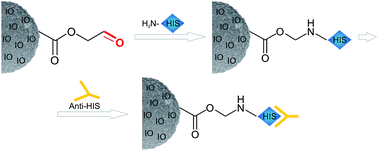Calf thymus histone-conjugated magnetic poly(2-oxoethyl methacrylate) microspheres for affinity isolation of anti-histone IgGs from the blood serum of patients with systemic lupus erythematosus
Abstract
Systemic lupus erythematosus (SLE) is a heterogeneous, inflammatory and multisystem autoimmune disease in which antinuclear antibodies are present in blood often years before clinical symptoms occur. Isolating the antibodies is thus of crucial importance to confirm the diagnosis and prognosis of patients with some autoimmune diseases. Isolation can be performed advantageously using magnetic microspheres, which offer easy and quick manipulation with a magnet and avoid sample dilution. Here, we developed calf thymus histone-conjugated magnetic poly(2-oxoethyl methacrylate) (POEMA–His) microspheres using a multiple-stage swelling technique followed by His immobilization. Magnetic POEMA–His microspheres were characterized using scanning and transmission electron microscopy, SQUID, ATR FT-IR spectroscopy, elemental analysis and atomic absorption spectrometry. The microspheres were successfully used for rapid purification of the anti-histone immunoglobulins (IgGs) from blood serum samples of a cohort of systemic lupus erythematosus patients.


 Please wait while we load your content...
Please wait while we load your content...